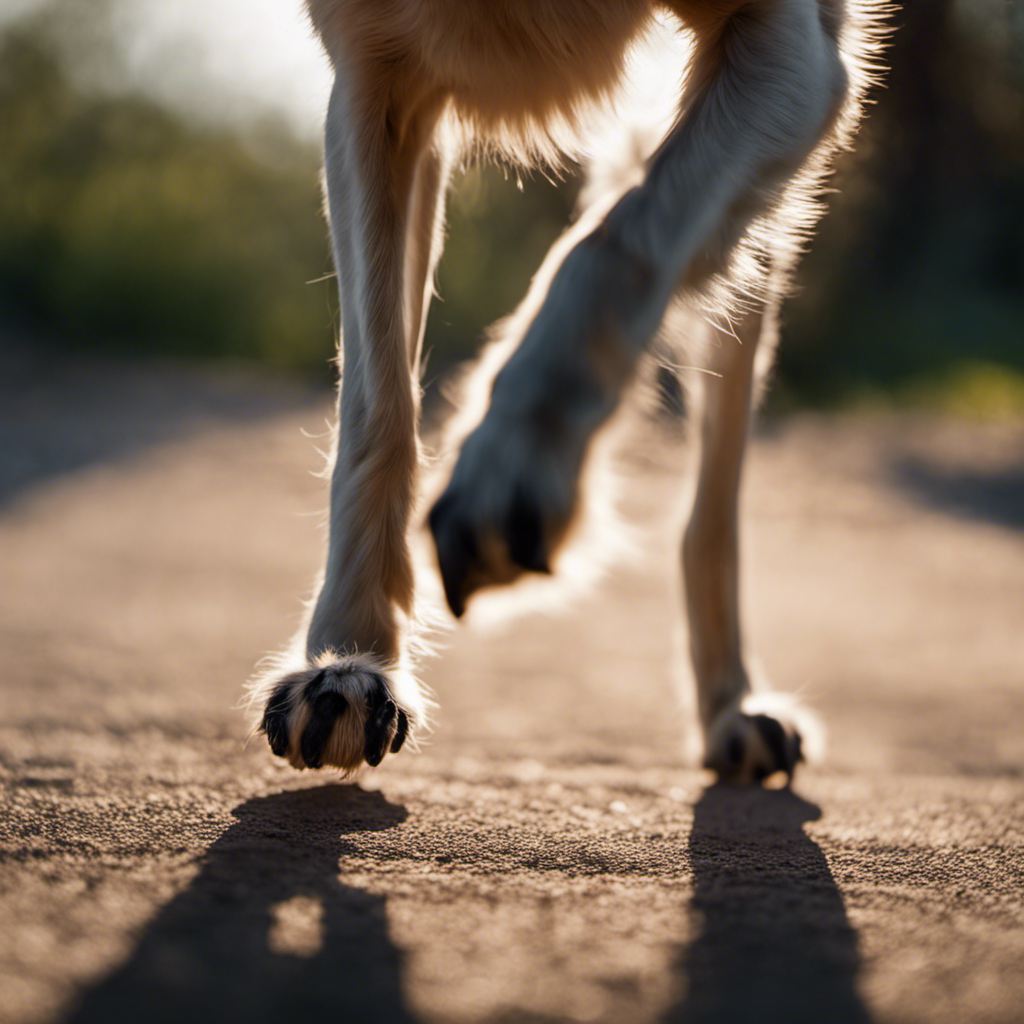- Key Takeaways
- The Importance of Teaching Your Dog the 'Passo' Command
- How to Properly Pronounce and Use the 'Passo' Command
- Step-by-Step Guide to Teaching Your Dog to 'Passo
- Common Challenges and Solutions When Training 'Passo
- Advanced Applications of the 'Passo' Command
- Incorporating 'Passo' Into Everyday Situations
- Tips and Tricks for Mastering 'Passo' Training With Your Dog
Click and GO TO THE BEST DOG NAME GENERATOR HERE

Are you tired of your dog constantly pulling on the leash during walks? Say goodbye to that struggle with the power of the ‘Passo’ command!
This simple yet effective Italian dog command will revolutionize your walks, allowing your furry friend to take calm and controlled steps by your side.
In this article, we will guide you through the importance of teaching ‘Passo’, pronunciation tips, step-by-step training, and even advanced applications.
Get ready to transform your walks into peaceful and enjoyable experiences with your canine companion!
- Key Takeaways
- The Importance of Teaching Your Dog the 'Passo' Command
- How to Properly Pronounce and Use the 'Passo' Command
- Step-by-Step Guide to Teaching Your Dog to 'Passo
- Common Challenges and Solutions When Training 'Passo
- Advanced Applications of the 'Passo' Command
- Incorporating 'Passo' Into Everyday Situations
- Tips and Tricks for Mastering 'Passo' Training With Your Dog
Key Takeaways
- Teaching the ‘Passo’ command can improve obedience and overall behavior in dogs.
- Non-verbal cues are beneficial for deaf dogs and can be used to teach the ‘Passo’ command.
- Patience and consistency are key in training dogs to understand and follow the ‘Passo’ command.
- Understanding the origin, variations, and meanings of the ‘Passo’ command is important for effective training.
The Importance of Teaching Your Dog the ‘Passo’ Command
You should teach your dog the ‘Passo’ command to improve their obedience and overall behavior. The ‘Passo’ command is an Italian dog command that means ‘step’ in English. It’s a simple yet effective command that can be taught using non-verbal cues, which have their own unique benefits in dog training.
Non-verbal cues, such as hand signals and body language, are useful because they can be easily understood by deaf dogs, who rely on visual cues for communication. By incorporating non-verbal cues in ‘Passo’ training, you can effectively communicate with your deaf dog and enhance their learning experience.
There are different training methods for teaching the ‘Passo’ command to deaf dogs. One method is to use a visual cue, such as a hand signal, to indicate the desired action. For example, you can lift your hand up to signal your dog to step forward. Another method is to use a touch cue, where you gently touch your dog’s paw to prompt them to take a step. This method can be particularly useful for dogs who are visually impaired or have limited mobility.
It’s important to be patient and consistent when training your dog, especially if they’re deaf. Using positive reinforcement, such as treats or praise, can also help motivate your dog and reinforce the desired behavior. By teaching your dog the ‘Passo’ command using non-verbal cues, you can enhance their obedience and improve their overall behavior.
How to Properly Pronounce and Use the ‘Passo’ Command
To properly pronounce and use the ‘Passo’ command, practice saying it with confidence and clarity, and then use it in conjunction with a clear hand signal to communicate the desired action to your dog.
The ‘Passo’ command has an interesting origin and history, as well as different variations and translations in other languages. Here are some key points to consider:
Origin and History:
- The ‘Passo’ command originated in Italy, where it’s commonly used in dog training.
- It’s derived from the Italian word ‘passo,’ which means ‘step’ in English.
- The command gained popularity due to its simplicity and effectiveness in teaching dogs to move forward or step in a certain direction.
Variations in Other Languages:
- In Spanish, the equivalent command is ‘paso,’ pronounced as ‘PAH-soh.’
- In French, it’s ‘pas,’ pronounced as ‘pah.’
- In German, it’s ‘schritt,’ pronounced as ‘shritt.’
- In Russian, it’s ‘шаг’ (shag), pronounced as ‘shahg.’
Step-by-Step Guide to Teaching Your Dog to ‘Passo
After you have familiarized yourself with the origin and variations of the ‘Passo’ command, follow this step-by-step guide to effectively teach your dog to ‘Passo’. Teaching your dog the ‘Passo’ command can have numerous benefits. Not only does it provide mental stimulation for your dog, but it also helps improve their focus and obedience. Additionally, teaching your dog this command can be a fun way to bond and strengthen your relationship.
To begin, make sure you have a clear understanding of the different variations of the ‘Passo’ command. Below is a table outlining the variations and their meanings:
| Variation | Meaning |
|---|---|
| Passo | Step |
| Passo lento | Slow step |
| Passo veloce | Fast step |
| Passo stretto | Narrow step |
| Passo largo | Wide step |
Now, let’s move on to the step-by-step guide:
- Start in a quiet and distraction-free environment.
- Stand in front of your dog and give the command “Passo.”
- Take a step forward and encourage your dog to follow.
- Reward your dog with praise and treats when they successfully take a step.
- Gradually increase the number of steps and introduce variations like “Passo lento” or “Passo veloce.”
Remember to be patient and consistent with your training. With practice, your dog will become proficient in the ‘Passo’ command, and you’ll both enjoy the benefits it brings.
Common Challenges and Solutions When Training ‘Passo
When training your dog to ‘Passo’, you may encounter common challenges such as difficulty in reinforcing the desired behavior and distractions that can hinder the training process.
To overcome these challenges, it’s important to consistently reward your dog for correctly performing the ‘Passo’ command and to use positive reinforcement techniques.
Additionally, minimizing distractions during training sessions can help your dog stay focused and improve their understanding of the command.
Reinforcing Desired Behavior
You can reinforce desired behavior by using treats and positive reinforcement when teaching your dog the Italian command ‘Passo. Positive reinforcement methods are effective in training dogs because they focus on rewarding good behavior rather than punishing bad behavior.
Here are four techniques to reinforce desired behavior during ‘Passo’ training:
-
Treats: Use small, tasty treats as rewards when your dog successfully follows the command. This will motivate them to continue performing the behavior.
-
Verbal praise: Along with treats, use verbal praise such as ‘Good job!’ or ‘Well done!’ to let your dog know they’re doing the right thing.
-
Clicker training: Incorporate a clicker to mark the exact moment your dog performs the desired behavior, followed by a treat or praise.
-
Consistency: Be consistent in using treats and positive reinforcement every time your dog correctly responds to the ‘Passo’ command. This will help reinforce the behavior and make it more likely to be repeated.
By reinforcing desired behavior using these techniques, your dog will learn the ‘Passo’ command effectively.
Now, let’s discuss overcoming distractions during training.
Overcoming Distractions During Training
One common distraction during ‘Passo’ training is the presence of other dogs nearby, making it difficult to focus on the command.
Overcoming distractions while walking is an important part of training your dog to obey the ‘Passo’ command in different environments.
To successfully teach your dog to ‘Passo’ despite distractions, it’s essential to start training in a controlled environment with minimal distractions.
Gradually increase the level of distractions as your dog becomes more proficient in following the command.
Use positive reinforcement techniques, such as treats and praise, to reward your dog for staying focused on the ‘Passo’ command despite distractions.
Consistency and patience are key when training your dog to overcome distractions while walking and obeying the ‘Passo’ command in various environments.
With practice and perseverance, you can help your dog become a well-behaved companion in any situation.
Advanced Applications of the ‘Passo’ Command
Step up your game by incorporating the ‘Passo’ command into complex training routines with your dog. Mastering this advanced technique won’t only enhance your dog’s obedience skills but also strengthen the bond between you and your furry friend.
Here are some common mistakes to avoid and advanced passo training techniques to consider:
-
Timing is crucial: Ensure that you give the ‘Passo’ command at the precise moment your dog starts to move. This will help them understand the association between the command and the desired action.
-
Gradual progression: Start by practicing ‘Passo’ in a controlled environment with minimal distractions. Once your dog demonstrates proficiency, gradually increase the level of difficulty by introducing distractions such as toys or other dogs.
-
Incorporate distance: As your dog becomes more proficient, start incorporating distance into the ‘Passo’ command. This will teach them to follow the command even from a distance, enhancing their off-leash reliability.
-
Add duration: Once your dog has mastered the basic ‘Passo’ command, challenge them by increasing the duration of the behavior. This will help build their focus and endurance.
By incorporating ‘Passo’ into everyday situations, such as walks or outings, you can reinforce their training and ensure they respond reliably in any situation.
Incorporating ‘Passo’ Into Everyday Situations
Incorporating ‘Passo’ into everyday situations can be a useful way to improve your dog’s obedience and ensure they’re well-behaved in various environments. Real-life scenarios such as walking on busy streets or encountering other dogs can be great opportunities to practice the ‘Passo’ command and reinforce your dog’s training.
Real-Life Passo Scenarios
Can you think of any situations where you’d need to take a step within a step? When it comes to training multiple dogs to ‘passo’ together, there are several real-life applications where this command can be incredibly useful.
Here are four scenarios where taking a step within a step can make a big difference:
-
Walking in crowded areas: When navigating through busy streets or parks, teaching your dogs to ‘passo’ helps them stay close to you and move in sync, making it easier to maneuver through the crowd.
-
Crossing the road: By training your dogs to ‘passo’ together, you can ensure they stay by your side during road crossings, reducing the risk of accidents.
-
Vet visits: Taking multiple dogs to the vet can be challenging, but having them walk in unison with the ‘passo’ command can simplify the process and keep everyone calm.
-
Off-leash adventures: When exploring off-leash areas, teaching your dogs to ‘passo’ helps them stick together and prevents them from wandering too far.
Effective Passo Training Strategies
To effectively train your dogs to ‘passo’ in various situations, try using consistent hand signals and positive reinforcement. Passo training techniques can be highly effective in teaching your dogs to step forward or move in a controlled manner. By incorporating hand signals that are easy for your dog to understand, such as a flat palm facing upwards, you can communicate the desired behavior clearly. Additionally, positive reinforcement in the form of treats or praise can motivate your dog to perform the ‘passo’ command correctly. However, it is important to troubleshoot any passo training issues that may arise. This can involve identifying any distractions or fear triggers that may hinder your dog’s progress and working on desensitization exercises. By following these strategies, you can improve your dog’s passo training and enhance their overall obedience skills.
| Pros | Cons |
|---|---|
| Clear communication | Distractions may hinder progress |
| Positive reinforcement motivates dogs | Fear triggers may require desensitization |
| Enhances overall obedience skills | Requires patience and consistency |
| Can be used in various situations | May take time for dogs to learn new command |
Tips and Tricks for Mastering ‘Passo’ Training With Your Dog
Are you struggling with perfecting ‘Passo’ training? Try incorporating small treats as rewards for each successful step! Rewards-based training techniques can be highly effective in shaping desired behaviors in dogs.
Here are some tips and tricks to help you master ‘Passo’ training with your furry friend:
-
Start with the basics:
Before diving into complex ‘Passo’ commands, ensure that your dog has a solid foundation in basic obedience training. This will make it easier for them to understand and follow instructions during ‘Passo’ training sessions. -
Break it down:
Break the ‘Passo’ command into smaller steps and teach your dog one step at a time. This will prevent overwhelm and confusion, allowing your dog to grasp the concept more easily. -
Be patient and consistent:
‘Passo’ training requires patience and consistency. Practice the command regularly, in short and focused training sessions. Consistency is key to reinforcing the desired behavior and helping your dog understand what’s expected of them. -
Troubleshoot common issues:
If you encounter any challenges during ‘Passo’ training, such as your dog not responding to the command or getting distracted, troubleshoot the issue. Evaluate the environment, adjust your training techniques if needed, and seek guidance from a professional dog trainer if necessary.
- Key Takeaways
- The Importance of Teaching Your Dog the 'Passo' Command
- How to Properly Pronounce and Use the 'Passo' Command
- Step-by-Step Guide to Teaching Your Dog to 'Passo
- Common Challenges and Solutions When Training 'Passo
- Advanced Applications of the 'Passo' Command
- Incorporating 'Passo' Into Everyday Situations
- Tips and Tricks for Mastering 'Passo' Training With Your Dog


